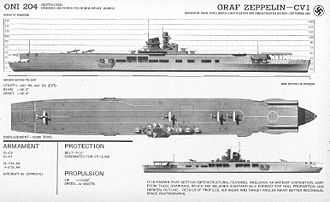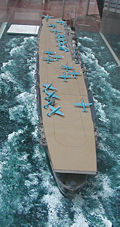German aircraft carrier Graf Zeppelin
 |
|
| Career (Germany) | |
|---|---|
| Name: | Graf Zeppelin |
| Ordered: | November 16 1935 |
| Laid down: | December 28 1936 |
| Launched: | December 8 1938 |
| Fate: | Sunk as a target ship on August 16, 1947 |
| General characteristics | |
| Displacement: | 33,550 tonnes |
| Length: | 262.5 m (861 ft 3 in) |
| Beam: | 31.5 m (103 ft 4 in) |
| Draft: | 7.6 m (24 ft 11 in) |
| Propulsion: | Geared turbines, 200,000 WPS (147,000 kW), four screws |
| Speed: | 35 kn (65 km/h) |
| Range: | 14,816 km (8,000 nmi) at 19 kn (35 km/h) |
| Complement: | 1,720 crew 306 flight personnel |
| Armament: | 16 × Sk. 15 cm. guns 12 × Flak (10.5 cm) 22 × Flak (3.7 cm) 28 × Flak (2.0 cm) |
| Aircraft carried: | Complement of 50 10 × Messerschmitt Bf 109 fighters 20 × Junkers Ju 87 dive bombers 20 × Fieseler Fi 167 torpedo bombers |
Graf Zeppelin was a German aircraft carrier of the Kriegsmarine, named like the famous airship in honour of Graf (Count) Ferdinand von Zeppelin. It was Germany's only aircraft carrier during World War II. Its construction was ordered on November 16, 1935, and its keel was laid down December 28, 1936 by Deutsche Werke of Kiel. It was launched on December 8, 1938, but was never completed.
Contents |
Planning and construction
Wilhelm Hadeler had been Assistant to the Professor of Naval Construction at the Technical University of Berlin for nine years when he was appointed to draft preliminary designs for an aircraft carrier in April 1934.[1] The Anglo-German Naval Treaty signed 18 June 1935 allowed Germany to construct aircraft carriers with displacement up to 38,500 tons.[2] In 1935, Adolf Hitler announced that Germany would construct aircraft carriers to strengthen the Kriegsmarine. A Luftwaffe officer, a naval officer and a constructor visited Japan in the autumn of 1935 to obtain flight deck equipment blueprints and inspect the Japanese aircraft carrier Akagi.[3] The keel of Graf Zeppelin was laid down the next year. Two years later, Großadmiral (Grand Admiral) Erich Raeder presented an ambitious shipbuilding program called Plan Z, in which four carriers were to be built by 1945. In 1939, he revised the plan, reducing the number to two.
The Kriegsmarine has always maintained a policy of not assigning a name to a ship until it is launched. The first German carrier, laid down as "Flugzeugträger A" ("Aircraft carrier A"), was named Graf Zeppelin when launched in 1938. The second carrier — never launched — bore only the title "Flugzeugträger B", but might, if completed, have been called Peter Strasser.[4]
A review of Hitler's conferences on the German Navy, the minutes of which were captured after the fall of the Third Reich, reveals his decreasing interest in the carriers. Reichsmarschall Hermann Göring, Commander of the Luftwaffe, was resentful of any incursion on his authority as head of the country's air power, and he frustrated Raeder at every opportunity. Within his own service, Raeder found opposition in Admiral Karl Dönitz, a submariner.
Having no experience building such ships, the Kriegsmarine had difficulty implementing advanced technologies such as steam-driven catapults into the Graf Zeppelin. German designers were able to study Japanese designs, but were constrained by the realities of creating a North Sea carrier vs. a "Blue Water" design. Several cruiser-type guns were envisioned to allow commerce raiding and defense against British cruisers, for example. This is in contrast to American and Japanese designs, which were more oriented toward a task-force defense, using supporting cruisers for surface firepower.
1941–1945

By May 1941, Raeder was still optimistic about the project and informed Hitler that Graf Zeppelin, then about 85% complete, would be completed in about a year and that another year would be required for sea trials and flight training.
Though Raeder continued to assure Hitler that the carriers would be built, the Admiral's battles with Göring became increasingly bitter. Göring showed his contempt for the naval air arm by informing Hitler and Raeder that the aircraft ordered for Graf Zeppelin could not be available until the end of 1944. Göring's delaying tactics worked.
Construction on the carriers had been fitful from the start. Flugzeugträger B was abandoned in 1940 and broken up. Worker and material shortages plagued Graf Zeppelin.
Prior to launch, the carrier air group emphasis had been reconnaissance similar to contemporary Royal Navy concepts. The original air complement was to be 20 Fieseler Fi 167 biplanes for scouting and torpedo attack, ten Messerschmitt Bf 109T fighters, and thirteen Junkers Ju 87G dive bombers.[5] Emphasis changed to offensive capabilities following observation of Japanese aircraft carrier operations against China in 1937. Poor performance of the Fi 167 changed the planned airgroup to thirty Messerschmitt fighters and twelve Junkers dive bombers.[6]
Prodded by Raeder, Hitler ordered Göring to produce aircraft for the carrier and under this pressure, the air marshal offered redesigned versions of the Junkers Ju 87B Stuka and the Messerschmitt Bf 109E, which were at that time being phased out of the Luftwaffe first-line squadrons. Raeder was unhappy, but he had to accept them or none at all (including Göring's insistence that the flying personnel would remain under Luftwaffe command). All this forced another delay in the construction of the carrier: the flight deck installations had to be changed.
Later in 1942 projects for naval aircraft included the Me 155 V2 and Ju 87E (navalized D version). None of the Ju 87E were completed.
By 1943, Hitler had become disenchanted with his Navy. Raeder was relieved at his own request and Dönitz, the submarine admiral, took the top naval post. Work on the 95% complete carrier stopped; all armaments were removed and transferred to coastal batteries in Norway. The hull itself was used to store hardwood for the Kriegsmarine. The carrier was scuttled in shallow water at Stettin (now Szczecin) on 25 April 1945, just before the Red Army captured the city.
Fate after the war


The carrier's history and fate after Germany's surrender was unclear for decades after the war. According to the terms of the Allied Tripartite Commission, a "Category C" ship (damaged or scuttled) should have been destroyed or sunk in deep water by August 15, 1946. Instead, the Soviets decided to repair the damaged ship and it was refloated in March 1946. The last known photo of the carrier shows it leaving Świnoujście (before 1945 Swinemünde) on April 7, 1947 (see picture). The photo appears to show the carrier deck loaded with various containers, boxes and construction elements, hence the supposition that it was probably used to carry looted factory equipment from Poland and Germany to the Soviet Union.
For many years, no other information about the ship's fate was available. There was some speculation that it was very unlikely that the hull made it to Leningrad, as it was argued that the arrival of such a large and unusual vessel would have been noticed by Western intelligence services. This seemed to imply that the hull was lost at sea during transfer between Świnoujście and Leningrad. One account concluded that it struck a mine north of Rügen on August 15, 1947, but Rügen, west of Swinemünde, is not on the sailing route to Leningrad. Further north in the Gulf of Finland, a heavily-mined area difficult for Western observers to monitor, seemed more likely.
After the opening of the Soviet archives, new light was shed on the mystery. Though some believed that the carrier had been towed to Leningrad after the war, in his book "Without wings, the story of Hitler's aircraft carrier" Burke disputed this. What is known is that the carrier was briefly designated as "PO-101" (Floating Base Number 101) until, on August 16, 1947, it was used as a practice target for Soviet ships and aircraft. Allegedly the Soviets installed aerial bombs on the flight deck, in hangars and even inside the funnels (to simulate a load of combat munitions), and then dropped bombs from aircraft and fired shells and torpedoes at it. This assault would both comply with the Tripartite mandate (albeit late) and provide the Soviets with experience in sinking an aircraft carrier. By this point, the Cold War was underway, and the Soviets were well aware of the large numbers and central importance of aircraft carriers in the U.S. Navy, which in the event of an actual war between the Soviet Union and the United States would be targets of high strategic importance. After being hit by 24 bombs and projectiles, the ship did not sink and had to be finished off by two torpedoes.[7] The exact position of the wreck was unknown for decades.
Discovery in 2006
On July 12, 2006 RV St. Barbara, a ship belonging to the Polish oil company Petrobaltic found a 265 m long wreck close to the port of Łeba (a BBC report says 55 km north of Władysławowo) which they thought was most likely Graf Zeppelin. On July 26, 2006 the crew of the Polish Navy's survey ship ORP Arctowski commenced penetration of the wreckage to confirm its identity, and the following day the Polish Navy confirmed that the wreckage was indeed that of Graf Zeppelin. She rests at more than 87 meters (264 feet) below the surface.[8][9]
References
- ↑ Reynolds, January 1967, p.42
- ↑ Reynolds, January 1967, p.43
- ↑ Reynolds, January 1967, p.44
- ↑ Green, William; Gordon Swanborough (1994). The Complete Book of Fighters. Salamander Books. ISBN 0-8317-3939-8.
- ↑ Reynolds, January 1967, p.44
- ↑ Reynolds, January 1967, pp.44-45
- ↑ Hitler’s last treasure belongs to Russia - Pravda.Ru
- ↑ Gera, Vanessa (July 28 2006). "Nazi aircraft carrier found in Baltic sea". Associated Press.
- ↑ "'Nazi aircraft carrier' located". BBC News (July 28 2006).
Bibliography
- Israel, Ullrich H. J., Graf Zeppelin - Einziger Deutscher Flugzeugträger (Verlag Koehler/Mittler, Hamburg 1994)
- Breyer, Siegfried, The German Aircraft Carrier Graf Zeppelin (Schiffer Publ. Co., West Chester, Pa. 1989)
- Burke, Stephen, 'Without wings, the story of Hitler's aircraft carrier' (Trafford publishing ISBN-10: 1425122167, Sept 07 ) http://www.withoutwingsonline.co.uk
- Reynolds, Clark G. (January 1967). Hitler's Flattop -- The End of the Beginning. United States Naval Institute Proceedings.
See also
- List of aircraft carriers
- List of World War II ships
- List of naval ships of Germany
- List of naval ship classes of Germany
- List of Kriegsmarine ships
- List of ship launches in 1938
- Flugzeugträger B - Graf Zeppelin's sister ship
External links
- Graf Zeppelin images from Bundesarchiv Freiburg (text in German but lots of images)
- Maritimequest Graf Zeppelin photo gallery
- Aerial photos of the carrier taken in 1947
- "Divers find Hitler's aircraft carrier" - Article from Times Online, published July 27 2006 (Roger Boyes)
- http://www.withoutwingsonline.co.uk
|
||||||||